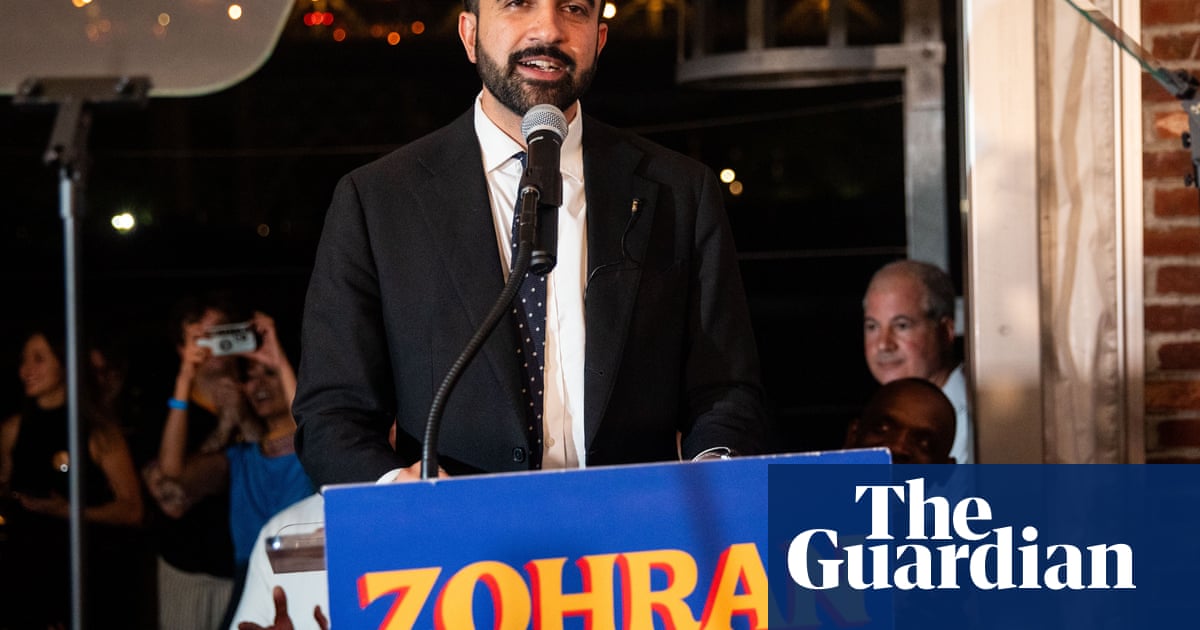How Mamdani connects climate policy to his affordability agenda as he runs for New York mayor | Zohran Mamdani

As she canvassed for Zohran Mamdani in New York City on Tuesday last week, Batul Hassan should have been elated. The mayoral candidate – a 33-year-old state assemblymember – was surging in the polls and would within hours soundly defeat Andrew Cuomo on first preference votes in the Democratic primary election.
But Hassan’s spirits were hampered by record-breaking temperatures. In Crown Heights, where she was the Mamdani campaign’s field captain, the heat index soared into the triple digits.
“I couldn’t think about anything but the heat,” she said. “It was so dangerous.”
Early that Tuesday morning, Hassan visited a public school polling site, where elderly workers sweltered without air conditioning. The city board of elections sent over paper fans, but they were no match for the heat.
If Mamdani is elected, that school could be retrofitted with air conditioning and green space to bring down temperatures as part of his green schools plan, or could even be transformed into a resilience hub for communities shelter amid extreme weather events.
“Seeing total infrastructural failure on election day emphasized the stakes of what’s happening with the climate crisis and the importance of the election,” said Hassan, who took time off from her day job at the leftist thinktank Climate and Community Institute to canvass.
Mamdani’s green schools plan is just one of his schemes to slash carbon emissions and boost environmental justice. If elected mayor, his plans for New York City would make residents “dramatically more safe” from extreme weather, said Hassan.
But the democratic socialist, who was endorsed by the national youth-led environmental justice group Sunrise Movement and student-led climate group TREEAge, did not place the climate crisis at the center of his campaign, instead choosing to focus relentlessly on cost-of-living issues. The model could help build popular support for climate policies, supporters say.
“Climate and quality of life are not two separate concerns,” Mamdani told the Nation in April. “They are, in fact, one and the same.”
Over the past two decades, Democrats increasingly focused on the climate. But often, their proposed schemes have been technocratic, Hassan said. Carbon taxes, for instance, can be impenetrably complex, making them difficult candidates for popular support. They can also be economically regressive, with “working class people experiencing them as an additional cost”, Hassan said.
More recently, Joe Biden coupled climate plans with green industrial policy and plans to boost employment. But even those projects can take years to affect tangible change, critics say. As president, for instance, Biden achieved historic climate investments in the Inflation Reduction Act (IRA). But its green incentives disproportionately benefited the wealthy, and its job creation remains invisible to most people around the country. One poll found only a quarter of Americans felt the IRA benefited them.
“Now with Trump, we see the pitfalls of the IRA, where there is real difficulty in consolidating enough political support to defend those climate policy achievements,” said Hassan.
Mamdani “learned from some of the mistakes” of the Biden administration, said Gustavo Gordillo, a co-chair of the New York City chapter of the Democratic Socialists of America, which supported Mamdani’s campaign. His housing plan, for instance, aims to lower planet-heating pollution by boosting density, but his signature promise is a rent freeze.
That pledge could ensure residents are not priced out of New York City and forced to move to more carbon-intensive suburbs, and prevent landlords from passing the costs of energy efficiency upgrades or air conditioning installation to renters, preventing displacement, said Hassan.
Similarly, Mamdani’s headline transit goal was to make buses faster and free, which could boost ridership and discourage the use of carbon-intensive cars.
“Public transit is one of the greatest gifts we have to take on the climate crisis,” Mamdani said at a February mayoral forum.
Biden’s IRA placed little focus on boosting public transit, said Gordillo. This was a missed opportunity to cut emissions and also lower Americans’ fuel costs, he said.
“We need to expand mass transit to fight the climate crisis, which hasn’t been a priority for the Democratic establishment,” said Gordillo, who is an electrician by day. “But we also need to expand it because we want to improve people’s lives right now.”
As a New York assemblymember, Mamdani has backed explicitly green policies. He was a key advocate for a boosting publicly owned renewable energy production. The effort aimed to help New York “live up to the dream of our state as being a climate leader”, he said in 2022.
He also fought fossil fuel buildout. He coupled that climate focus with efforts to keep energy bills low, consistently opposing local utilities’ attempts to impose rate hikes, said Kim Fraczek, director of the climate nonprofit Sane Energy Project.
“His growing political influence is a clear win for communities demanding a just transition: renewable power, democratic control and relief from crushing energy costs,” said Fraczek.
Progressive cities like New York are often climate leaders. But if they price out working people, only the wealthy get to see the benefits of their green policies, Mamdani’s backers say.
By crafting popular climate policies, the Democratic nominee is also building a base of New Yorkers who will work to defend those plans in the face of threats from the Trump administration, they say.
“New Yorkers want an affordable city, clean and green schools, fast and free buses, and a rent freeze,” said Daniel Goulden, a co-chair of the New York City Democratic Socialists of America ecosocialist working Group. “But most importantly, New Yorkers want a future – one where they can live and thrive in New York.”



